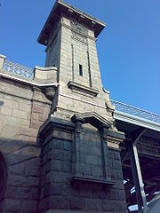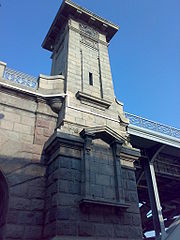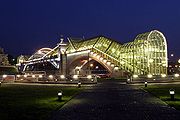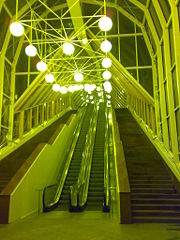
Krasnoluzhsky Bridge
Encyclopedia
The name Krasnoluzhsky Bridge refers to three existing bridges across Moskva River
, located between Kievsky Rail Terminal
and Luzhniki
in Moscow
.

 The original Nicholas II
The original Nicholas II
Bridge (Мост Николая II) and its twin, Sergievsky Bridge (now known as Andreyevsky Bridge
, Андреевский мост) were built in 1903–1907. They carried two tracks of Moscow Inner Ring Railroad across the Luzhniki
bend. Both were designed as through arch bridges by Lavr Proskuryakov
(structural engineering
) and Alexander Pomerantsev
(architectural design). The 135-meter steel arch of Nicholas II Bridge (1400 metric tons) was made at Sormovo works. Proskuryakov's work, considered a marvel of engineering, was proven by the 1908 flood: water level exceeded the maximum design specification by a meter and a half; the bridges stood unharmed. After the February Revolution
of 1917, the tzarist title was replaced with a politically correct Krasnoluzhsky, literally Red Meadows. In 1926 the builder, Lavr Proskuryakov, was buried at Novodevichy Cemetery
- right next to the bridge.
In 1952–1956, the arched stone pillars over embankments were extended from one to two spans (each side) to accommodate street traffic; inner steel frame of these arches was replaced by concrete. Eventually, after more than 90 years of service, the bridge required extensive repairs. The City preferred to replace the whole steel structure with a brand new arch over existing pillars; this was completed in 2001. New steel arch is superficially similar (but not identical) to Proskuryakov's original design. The function of the bridge was not changed, it carries a railway line across Moskva River
.
 In the 1990s, the City built the Third Ring Road (Moscow) , parallel to existing railway tracks. New Krasnoluzhsky Road Bridge (Краснолужский автодорожный мост) construction began in September 1997 and completed in 1998. Designers took care to make the new concrete bridge "blend" with Proskuryakov's arch, thus the main span of a dual box girder bridge
In the 1990s, the City built the Third Ring Road (Moscow) , parallel to existing railway tracks. New Krasnoluzhsky Road Bridge (Краснолужский автодорожный мост) construction began in September 1997 and completed in 1998. Designers took care to make the new concrete bridge "blend" with Proskuryakov's arch, thus the main span of a dual box girder bridge
is set to 144.5 meters (complete formula is 24+110+144.5+110+24). Roadway is 39.5 meters wide (8 regular lanes, 2 reserve lanes, a single foot and bicycle lane).
Originally, the bridge was known as Berezhkovsky (Бережковский). This title appears in a contractor's illustrated report available online.

 Instead of scrapping the old steel arch, city planners re-used it as a structural core of the new pedestrian bridge, half a mile upstream. Originally named Kievsky (Киевский мост), i.e. "Kiev Bridge", this bridge is now officially named after Bohdan Khmelnytskyi (Мост Богдана Хмельницкого), hetman
Instead of scrapping the old steel arch, city planners re-used it as a structural core of the new pedestrian bridge, half a mile upstream. Originally named Kievsky (Киевский мост), i.e. "Kiev Bridge", this bridge is now officially named after Bohdan Khmelnytskyi (Мост Богдана Хмельницкого), hetman
of the Zaporozhian Cossack Hetmanate
of Ukraine
. Main pedestrian walkway and stairs are completely enclosed in a glass canopy; there are two open-air side walkways. Shoreside pillars and staircases of grey stone are a close but simplified copy of the original Krasnoluzhsky bridge approaches. The bridge was opened on the official Day of Moscow, 2 September 2001. Completion was in such a rush that it made its way into the official Bridges of Moscow reference book (2004 edition): "One week before opening, there were six cranes and derricks working 24 hours a day!"
Moskva River
The Moskva River is a river that flows through the Moscow and Smolensk Oblasts in Russia, and is a tributary of the Oka River.-Etymology:...
, located between Kievsky Rail Terminal
Kievsky Rail Terminal
The Kiyevsky Rail Terminal is one of the nine rail terminals of Moscow, Russia. It is the only railway station in Moscow to have a frontage on the Moskva River....
and Luzhniki
Luzhniki
Luzhniki may refer to:*Luzhniki , a village in Moscow Oblast, Russia*Luzhniki Olympic Complex, sport complex in Moscow, Russia.**Luzhniki Palace of Sports, an arena in Luzhniki Olympic Complex...
in Moscow
Moscow
Moscow is the capital, the most populous city, and the most populous federal subject of Russia. The city is a major political, economic, cultural, scientific, religious, financial, educational, and transportation centre of Russia and the continent...
.
Krasnoluzhsky Rail Bridge (1907, structure replacement 2001)


Nicholas II of Russia
Nicholas II was the last Emperor of Russia, Grand Prince of Finland, and titular King of Poland. His official short title was Nicholas II, Emperor and Autocrat of All the Russias and he is known as Saint Nicholas the Passion-Bearer by the Russian Orthodox Church.Nicholas II ruled from 1894 until...
Bridge (Мост Николая II) and its twin, Sergievsky Bridge (now known as Andreyevsky Bridge
Andreyevsky Bridge
Andreyevsky Bridge name refers to a historical bridge demolished in 1998 and three existing bridges across Moskva River, located between Luzhniki and Gorky Park in Moscow.- Andreyevsky Rail Bridge :...
, Андреевский мост) were built in 1903–1907. They carried two tracks of Moscow Inner Ring Railroad across the Luzhniki
Luzhniki
Luzhniki may refer to:*Luzhniki , a village in Moscow Oblast, Russia*Luzhniki Olympic Complex, sport complex in Moscow, Russia.**Luzhniki Palace of Sports, an arena in Luzhniki Olympic Complex...
bend. Both were designed as through arch bridges by Lavr Proskuryakov
Lavr Proskuryakov
Lavr Dmitrievich Proskuryakov was a leading bridge builder of Imperial Russia.Proskuryakov was responsible for many bridges constructed along the Trans-Siberian Railway, including the one crossing the Kotorosl River in Yaroslavl , another spanning the Yenisey near Krasnoyarsk and the Khabarovsk...
(structural engineering
Structural engineering
Structural engineering is a field of engineering dealing with the analysis and design of structures that support or resist loads. Structural engineering is usually considered a specialty within civil engineering, but it can also be studied in its own right....
) and Alexander Pomerantsev
Alexander Pomerantsev
Alexander Nikanorovich Pomerantsev was a Russian architect and educator responsible for some of the most ambitious architectural projects realized in Imperial Russia and Bulgaria at the turn of the 20th century...
(architectural design). The 135-meter steel arch of Nicholas II Bridge (1400 metric tons) was made at Sormovo works. Proskuryakov's work, considered a marvel of engineering, was proven by the 1908 flood: water level exceeded the maximum design specification by a meter and a half; the bridges stood unharmed. After the February Revolution
February Revolution
The February Revolution of 1917 was the first of two revolutions in Russia in 1917. Centered around the then capital Petrograd in March . Its immediate result was the abdication of Tsar Nicholas II, the end of the Romanov dynasty, and the end of the Russian Empire...
of 1917, the tzarist title was replaced with a politically correct Krasnoluzhsky, literally Red Meadows. In 1926 the builder, Lavr Proskuryakov, was buried at Novodevichy Cemetery
Novodevichy Cemetery
Novodevichy Cemetery is the most famous cemetery in Moscow, Russia. It is next to the 16th-century Novodevichy Convent, which is the city's third most popular tourist site. It should not be confused with the Novodevichy Cemetery in Saint Petersburg....
- right next to the bridge.
In 1952–1956, the arched stone pillars over embankments were extended from one to two spans (each side) to accommodate street traffic; inner steel frame of these arches was replaced by concrete. Eventually, after more than 90 years of service, the bridge required extensive repairs. The City preferred to replace the whole steel structure with a brand new arch over existing pillars; this was completed in 2001. New steel arch is superficially similar (but not identical) to Proskuryakov's original design. The function of the bridge was not changed, it carries a railway line across Moskva River
Moskva River
The Moskva River is a river that flows through the Moscow and Smolensk Oblasts in Russia, and is a tributary of the Oka River.-Etymology:...
.
Krasnoluzhsky Road Bridge (1998)

Box girder bridge
A box girder bridge is a bridge in which the main beams comprise girders in the shape of a hollow box. The box girder normally comprises either prestressed concrete, structural steel, or a composite of steel and reinforced concrete. The box is typically rectangular or trapezoidal in cross-section...
is set to 144.5 meters (complete formula is 24+110+144.5+110+24). Roadway is 39.5 meters wide (8 regular lanes, 2 reserve lanes, a single foot and bicycle lane).
Originally, the bridge was known as Berezhkovsky (Бережковский). This title appears in a contractor's illustrated report available online.
Bogdan Khmelnitsky (Kievsky) Pedestrian Bridge (2001)


Hetman
Hetman was the title of the second-highest military commander in 15th- to 18th-century Poland and the Grand Duchy of Lithuania, which together, from 1569 to 1795, comprised the Polish-Lithuanian Commonwealth, or Rzeczpospolita....
of the Zaporozhian Cossack Hetmanate
Cossack Hetmanate
The Hetmanate or Zaporizhian Host was the Ruthenian Cossack state in the Central Ukraine between 1649 and 1782.The Hetmanate was founded by first Ukrainian hetman Bohdan Khmelnytsky during the Khmelnytsky Uprising . In 1654 it pledged its allegiance to Muscovy during the Council of Pereyaslav,...
of Ukraine
Ukraine
Ukraine is a country in Eastern Europe. It has an area of 603,628 km², making it the second largest contiguous country on the European continent, after Russia...
. Main pedestrian walkway and stairs are completely enclosed in a glass canopy; there are two open-air side walkways. Shoreside pillars and staircases of grey stone are a close but simplified copy of the original Krasnoluzhsky bridge approaches. The bridge was opened on the official Day of Moscow, 2 September 2001. Completion was in such a rush that it made its way into the official Bridges of Moscow reference book (2004 edition): "One week before opening, there were six cranes and derricks working 24 hours a day!"
See also
- Andreyevsky BridgeAndreyevsky BridgeAndreyevsky Bridge name refers to a historical bridge demolished in 1998 and three existing bridges across Moskva River, located between Luzhniki and Gorky Park in Moscow.- Andreyevsky Rail Bridge :...
- List of bridges in Moscow

